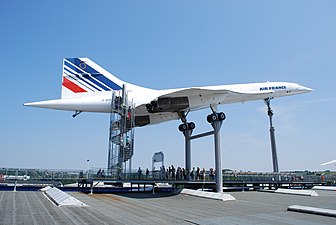A | B | C | D | E | F | G | H | CH | I | J | K | L | M | N | O | P | Q | R | S | T | U | V | W | X | Y | Z | 0 | 1 | 2 | 3 | 4 | 5 | 6 | 7 | 8 | 9
In fluid dynamics, drag (sometimes called air resistance, a type of friction, or fluid resistance, another type of friction or fluid friction) is a force acting opposite to the relative motion of any object moving with respect to a surrounding fluid.[1] This can exist between two fluid layers (or surfaces) or between a fluid and a solid surface. Unlike other resistive forces, such as dry friction, which are nearly independent of velocity, the drag force depends on velocity.[2][3]
Drag force is proportional to the velocity for low-speed flow and the squared velocity for high speed flow, where the distinction between low and high speed is measured by the Reynolds number. Even though the ultimate cause of a drag is viscous friction, the turbulent drag is independent of viscosity.[4]
Drag forces always tend to decrease fluid velocity relative to the solid object in the fluid's path.
Examples
Examples of drag include the component of the net aerodynamic or hydrodynamic force acting opposite to the direction of movement of a solid object such as cars (automobile drag coefficient), aircraft[3] and boat hulls; or acting in the same geographical direction of motion as the solid, as for sails attached to a down wind sail boat, or in intermediate directions on a sail depending on points of sail.[5][6][7] In the case of viscous drag of fluid in a pipe, drag force on the immobile pipe decreases fluid velocity relative to the pipe.[8][9]
In the physics of sports, the drag force is necessary to explain the motion of balls, javelins, arrows and frisbees and the performance of runners and swimmers.[10]
Types
| Shape and flow | Form Drag |
Skin friction |
|---|---|---|
| ≈0% | ≈100% | |
| ≈10% | ≈90% | |

|
≈90% | ≈10% |

|
≈100% | ≈0% |
Types of drag are generally divided into the following categories:
- form drag or pressure drag due to the size and shape of a body
- skin friction drag or viscous drag due to the friction between the fluid and a surface which may be the outside of an object or inside such as the bore of a pipe
The effect of streamlining on the relative proportions of skin friction and form drag is shown for two different body sections, an airfoil, which is a streamlined body, and a cylinder, which is a bluff body. Also shown is a flat plate illustrating the effect that orientation has on the relative proportions of skin friction and pressure difference between front and back. A body is known as bluff (or blunt) if the source of drag is dominated by pressure forces and streamlined if the drag is dominated by viscous forces. Road vehicles are bluff bodies.[11] For aircraft, pressure and friction drag are included in the definition of parasitic drag. Parasite drag is often expressed in terms of a hypothetical (in so far as there is no edge spillage drag[12]) "equivalent parasite drag area" which is the area of a flat plate perpendicular to the flow. It is used for comparing the drag of different aircraft. For example, the Douglas DC-3 has an equivalent parasite area of 23.7 sq ft and the McDonnell Douglas DC-9, with 30 years of advancement in aircraft design, an area of 20.6 sq ft although it carried five times as many passengers.[13]
- lift-induced drag appears with wings or a lifting body in aviation and with semi-planing or planing hulls for watercraft
- wave drag (aerodynamics) is caused by the presence of shockwaves and first appears at subsonic aircraft speeds when local flow velocities become supersonic. The wave drag of the supersonic Concorde prototype aircraft was reduced at Mach 2 by 1.8% by applying the area rule which extended the rear fuselage 3.73m on the production aircraft.[14]
- wave resistance (ship hydrodynamics) or wave drag occurs when a solid object is moving along a fluid boundary and making surface waves
- boat-tail drag on an aircraft is caused by the angle with which the rear fuselage, or engine nacelle, narrows to the engine exhaust diameter.[15]
The drag equation

Drag depends on the properties of the fluid and on the size, shape, and speed of the object. One way to express this is by means of the drag equation:
where
- is the drag force,
- is the density of the fluid,[16]
- is the speed of the object relative to the fluid,
- is the cross sectional area, and
- is the drag coefficient – a dimensionless number.
The drag coefficient depends on the shape of the object and on the Reynolds number
- ,
where
- is some characteristic diameter or linear dimension. Actually it is the equivalent diameter of the object. For a sphere is the D of the sphere itself.
- For a rectangular shape cross-section in the motion direction, , where a and b are the rectangle edges.
- is the kinematic viscosity of the fluid (equal to the dynamic viscosity divided by the density ).
At low , is asymptotically proportional to , which means that the drag is linearly proportional to the speed, i.e. the drag force on a small sphere moving through a viscous fluid is given by the Stokes Law:
At high , is more or less constant and drag will vary as the square of the speed. The graph to the right shows how varies with for the case of a sphere. Since the power needed to overcome the drag force is the product of the force times speed, the power needed to overcome drag will vary as the square of the speed at low Reynolds numbers and as the cube of the speed at high numbers.
It can be demonstrated that drag force can be expressed as a function of a dimensionless number, which is dimensionally identical to the Bejan number.[17] Consequently, drag force and drag coefficient can be a function of Bejan number. In fact, from the expression of drag force it has been obtained:
and consequently allows expressing the drag coefficient as a function of Bejan number and the ratio between wet area and front area :[17]
where is the Reynolds number related to fluid path length L.
At high velocity
As mentioned, the drag equation with a constant drag coefficient gives the force experienced by an object moving through a fluid at relatively large velocity (i.e. high Reynolds number, Re > ~1000). This is also called quadratic drag. The equation is attributed to Lord Rayleigh, who originally used L2 in place of A (L being some length).
The reference area A is often orthographic projection of the object (frontal area)—on a plane perpendicular to the direction of motion—e.g. for objects with a simple shape, such as a sphere, this is the cross sectional area. Sometimes a body is a composite of different parts, each with a different reference areas, in which case a drag coefficient corresponding to each of those different areas must be determined.
In the case of a wing the reference areas are the same and the drag force is in the same ratio to the lift force as the ratio of drag coefficient to lift coefficient.[18] Therefore, the reference for a wing is often the lifting area ("wing area") rather than the frontal area.[19]
For an object with a smooth surface, and non-fixed separation points—like a sphere or circular cylinder—the drag coefficient may vary with Reynolds number Re, even up to very high values (Re of the order 107). [20] [21] For an object with well-defined fixed separation points, like a circular disk with its plane normal to the flow direction, the drag coefficient is constant for Re > 3,500.[21] Further the drag coefficient Cd is, in general, a function of the orientation of the flow with respect to the object (apart from symmetrical objects like a sphere).
Power
Under the assumption that the fluid is not moving relative to the currently used reference system, the power required to overcome the aerodynamic drag is given by:
Note that the power needed to push an object through a fluid increases as the cube of the velocity. A car cruising on a highway at 50 mph (80 km/h) may require only 10 horsepower (7.5 kW) to overcome aerodynamic drag, but that same car at 100 mph (160 km/h) requires 80 hp (60 kW).[22] With a doubling of speed the drag (force) quadruples per the formula. Exerting 4 times the force over a fixed distance produces 4 times as much work. At twice the speed the work (resulting in displacement over a fixed distance) is done twice as fast. Since power is the rate of doing work, 4 times the work done in half the time requires 8 times the power.
When the fluid is moving relative to the reference system (e.g. a car driving into headwind) the power required to overcome the aerodynamic drag is given by:
Where is the wind speed and is the object speed (both relative to ground).
Velocity of a falling object

The velocity as a function of time for an object falling through a non-dense medium, and released at zero relative-velocity v = 0 at time t = 0, is roughly given by a function involving a hyperbolic tangent (tanh):
The hyperbolic tangent has a limit value of one, for large time t. In other words, velocity asymptotically approaches a maximum value called the terminal velocity vt:
For an object falling and released at relative-velocity v = vi at time t = 0, with vi < vt, is also defined in terms of the hyperbolic tangent function:
For vi > vt, the velocity function is defined in terms of the hyperbolic cotangent function:
The hyperbolic cotangent has also a limit value of one, for large time t. Velocity asymptotically tends to the terminal velocity vt, strictly from above vt.
For vi = vt, the velocity is constant:
Actually, these functions are defined by the solution of the following differential equation:
Or, more generically (where F(v) are the forces acting on the object beyond drag):
For a potato-shaped object of average diameter d and of density ρobj, terminal velocity is about
Text je dostupný za podmienok Creative
Commons Attribution/Share-Alike License 3.0 Unported; prípadne za ďalších
podmienok.
Podrobnejšie informácie nájdete na stránke Podmienky
použitia.





































